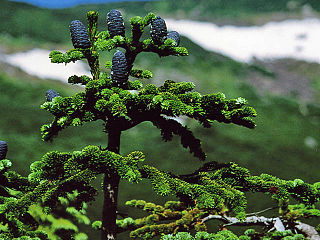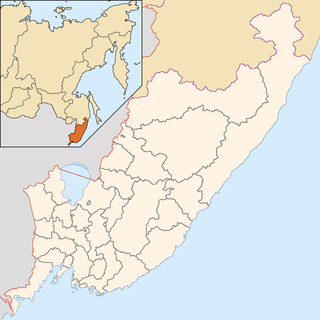Related Research Articles

Temperate broadleaf and mixed forest is a temperate climate terrestrial habitat type defined by the World Wide Fund for Nature, with broadleaf tree ecoregions, and with conifer and broadleaf tree mixed coniferous forest ecoregions.

Temperate rainforests are rainforests with coniferous or broadleaf forests that occur in the temperate zone and receive heavy rain.

Laurel forest, also called laurisilva or laurissilva, is a type of subtropical forest found in areas with high humidity and relatively stable, mild temperatures. The forest is characterized by broadleaf tree species with evergreen, glossy and elongated leaves, known as "laurophyll" or "lauroid". Plants from the laurel family (Lauraceae) may or may not be present, depending on the location.

The Scandinavian coastal conifer forests or Norwegian coastal conifer forest is a Palearctic ecoregion in the temperate coniferous forests biome, located along the coast of Norway. Within it are a number of small areas with botanical features and a local climate consistent with a temperate rainforest.

Abies mariesii is a fir native to the mountains of central and northern Honshū, Japan. It grows at altitudes of 750–1,900 m in northern Honshū, and 1,800–2,900 m in central Honshū, always in temperate rain forest with high rainfall and cool, humid summers, and very heavy winter snowfall.

The Appalachian mixed mesophytic forests is an ecoregion of the temperate broadleaf and mixed forests biome, as defined by the World Wildlife Fund. It consists of mesophytic plants west of the Appalachian Mountains in the Southeastern United States.

The Taiwan subtropical evergreen forests is an ecoregion that covers most of the island of Taiwan, with the exception of the southern tip of the island, which constitutes the South Taiwan monsoon rain forests ecoregion. The island's concentrated steep mountains host a range of forest types, from subtropical forests in the lowlands to temperate and alpine or montane forests.
The wildlife of Japan includes its flora, fauna, and natural habitats. The islands of Japan stretch a long distance from north to south and cover a wide range of climatic zones. This results in a high diversity of wildlife despite Japan's isolation from the mainland of Asia. In the north of the country, north of Blakiston's Line, there are many subarctic species which have colonized Japan from the north. In the south there are south-east Asian species, typical of tropical regions. Between these areas lies the temperate zone which shares many species with China and Korea. Japan also has many endemic species that are found nowhere else in the world, making it home to many endangered/rare species.

Abies sachalinensis, the Sakhalin fir, is a species of conifer in the family Pinaceae. It is found in Sakhalin island and southern Kurils (Russia), and also in northern Hokkaido (Japan). The first discovery by a European was by Carl Friedrich Schmidt (1832-1908), the Baltic German botanist, on the Russian island of Sakhalin in 1866, but he did not introduce it to Europe. The plant was re-discovered by the English plant-collector, Charles Maries in 1877 near Aomori on the main Japanese island of Honshū, who initially thought it to be a variety of Abies veitchii. Abies nephrolepis is known to be the closest relative, which exists on the mainland just west of the range of Sakhalin fir.

Mediterranean conifer and mixed forests is an ecoregion, in the temperate coniferous forest biome, which occupies the high mountain ranges of North Africa. The term is also a botanically recognized plant association in the African and Mediterranean literature.

The Taiheiyo evergreen forests is a temperate broadleaf forest ecoregion of Japan.

The Sierra Nevada lower montane forest is a plant community along a strip along the western and eastern edges of the Sierra Nevada mountain range in California. This zone is also known as a yellow pine forest.

The Ecology of the North Cascades is heavily influenced by the high elevation and rain shadow effects of the mountain range. The North Cascades is a section of the Cascade Range from the South Fork of the Snoqualmie River in Washington, United States, to the confluence of the Thompson and Fraser Rivers in British Columbia, Canada, where the range is officially called the Cascade Mountains but is usually referred to as the Canadian Cascades. The North Cascades Ecoregion is a Level III ecoregion in the Commission for Environmental Cooperation's classification system.

The South Apennine mixed montane forests is an ecoregion in the southern Apennine Mountains of southern Italy and Sicily. It has a Mediterranean climate, and is in the Mediterranean forests, woodlands, and scrub biome.

The North Central Rockies forests is a temperate coniferous forest ecoregion of Canada and the United States. This region overlaps in large part with the North American inland temperate rainforest and gets more rain on average than the South Central Rockies forests and is notable for containing the only inland populations of many species from the Pacific coast.

The Great Basin montane forests is an ecoregion of the Temperate coniferous forests biome, as designated by the World Wildlife Fund (WWF).
Mixed coniferous forest is a vegetation type dominated by a mixture of broadleaf trees and conifers. It is generally located in mountains, below the upper montane vegetation type.

The temperate rainforests of the Russian Far East are within the Russian federal subjects Primorsky Krai and Khabarovsk Krai and contains the Sikhote-Alin mountain range. Found within the Russian Federation, this area is one of the most productive and diverse forests in the world and also contains one of the highest endangered species densities on Earth. While most temperate rainforests around the world have retained only a fraction of their historical range, these forests maintain the majority of their former range and almost all of their historical biodiversity. The region is also notable for having what has become the last remaining large tract of viable habitat for the critically endangered Amur tiger and Amur leopard.

The North American inland temperate rainforest is a 7 million hectare disjunct temperate rainforest spreading over parts of British Columbia in Canada as well as Washington, Idaho and Montana on the US side. Its patches are located on the windward slopes of the Rocky Mountains and the Columbia Mountains, extending roughly over 1000km from 54° North to 45° North. It is one of the largest inland temperate rainforests in the world.

The Hokkaidō deciduous forests ecoregion covers the northern and southern coasts of the island of Hokkaido, the northernmost of the main islands of Japan. The region sits in the transition zone between the colder subarctic forests to the north and the more temperate forests to the south. Characteristic trees include Mongolian oak, Basswood, and Ash trees.
References
- 1 2 3 4 5 Murata, Gen (2005). "Flora and vegetation zone of Japan". The Japanese Society for Plant Systematics. 28 (1): 1–8.
- 1 2 3 4 5 DellaSala, Dominick A. (2011), Temperate and Boreal Rainforests of the World: Ecology and Conservation, Island Press, pp. 181–194
- ↑ "Weather, Climate & Earthquake Information". Japan Meteorological Agency . Retrieved November 1, 2013.
- 1 2 3 "Annual Report on Trends in Forests and Forestry Summary 2008". Forest Agency Hokkaidou Regional Office. Retrieved November 1, 2013.
- ↑ Tanaka, Nobuyuki; Matsui, Tetsuya; Tsuyama, Isotaro; Kominami, Hiroshi (2012), "Determination of climatic factors for plant destribution and estimation of habitat movement", Meteorological Society of Japan, 411 (306): 681–686
- ↑ Eguchi, Hiroshi (2004). "Ecosystem formation and preservatioin of Yakushima, Part II. Forest as a central". Kyushu Sangyo University Report. 36: 91–101.
- ↑ Yagashira, Ken (1961). "Summary of Natural forest vegetation in Kii Peninsula". The Japanese Society of Forest Environment. 2 (2): 60–63.
- 1 2 "Yoshino Kumano National Park of Japan". Ministry of Environment Kinki Regional Office. Retrieved November 1, 2013.
- ↑ "About the Yakushima National Park". The Yakushima World Heritage Center. Ministry of Environment. Retrieved November 1, 2013.
- ↑ "The Shirakami-Sanchi World Heritage Conservation Center". Ministry of Environment. Retrieved October 25, 2013.
- ↑ Nakamura, Toshihiko; Honda, Yuko (2010). "Meaning and concept change of Satoyama and Satoumi". Chiba Biodiversity Center Report.
- 1 2 Takeuchi, Kazuhito (2010). "Rebuilding the relationship between people and nature: the Satoyama Initiative". Ecological Research. 25 (5): 891–897. doi: 10.1007/s11284-010-0745-8 .
- 1 2 Kobayashi, K; Ueda, Akira (2005). "Wilt Disease of Fagaceae Trees Caused bv Platypus quercivorus (Murayama) (Coleoptera: Platypodidae) and the Associated Fungus: Aim is to Clarify the Damage Factor". Journal of the Japanese Forest Society. 87 (5): 435–450. doi: 10.4005/jjfs.87.435 .